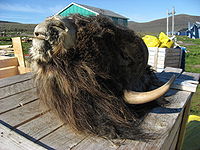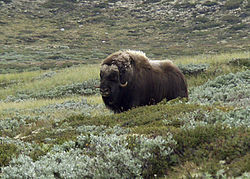- Muskox
-
Muskox 
Conservation status Scientific classification Kingdom: Animalia Phylum: Chordata Class: Mammalia Order: Artiodactyla Family: Bovidae Subfamily: Caprinae Genus: Ovibos
Blainville, 1816Species: O. moschatus Binomial name Ovibos moschatus
(Zimmermann, 1780)
Range map. Blue indicates areas where the muskox has been successfully introduced in the 20th century. Red indicates established range. The muskox (Ovibos moschatus, musk ox) is an Arctic mammal of the family Bovidae, noted for its thick coat and for the strong odor emitted by males, from which its name derives. This musky odor is used to attract females during mating season. Muskoxen primarily live in Arctic North America and Greenland,[2] with small introduced populations in Sweden, Siberia and Norway.
Contents
Evolution
The muskox, or its ancestor, is believed to have migrated to North America between 200,000[3] and 90,000 years ago,[4] during the Pleistocene period,[5] when it was a contemporary of the woolly mammoth. It is thought that the muskox was able to survive the last ice age (Wisconsin glaciation) by finding ice-free areas away from prehistoric peoples.[4] The muskox gradually moved across North America and arrived in Greenland during the late Holocene.[6]
Physical characteristics
As members of the subfamily Caprinae of the family Bovidae, muskoxen are more closely related to sheep and goats than to oxen, but are in their own genus, Ovibos (Latin: "sheep-ox"). Both sexes have long curved horns. Muskoxen stand 1.2 m (4 ft) high at the shoulder on average, with females measuring 135 to 200 cm (4.4 to 6.6 ft) in length, and males 200 to 250 cm (6.6 to 8.2 ft). Adults, on average, weigh 285 kg (600 lb) and range from 180 to 400 kg (400 to 900 lb).[7] Their life expectancy is 12–20 years. The thick coat and large head often suggests a larger animal than the muskox truly is, but heavy zoo-kept specimens have weighed up to 650 kilograms (1,400 lb).[8] Their coat, a mix of black, gray, and brown, includes long guard hairs that almost reach the ground. Rare "white muskoxen" have been spotted in the Queen Maud Gulf Bird Sanctuary.[9] Muskoxen are occasionally domesticated for wool,[10] meat and milk.[citation needed] The wool, qiviut, is highly prized for its softness, length, and insulation value. Prices for yarn range between $40 and $80 per ounce (28 g).[11][12][13]
Range and ecology
 Musk ox family in east Greenland
Musk ox family in east Greenland
Muskoxen are native to the Arctic areas of Canada, Greenland, and the United States. The Alaska population was wiped out in the late 19th or early 20th century. Their depletion has been attributed to over hunting, but it may alternatively be because the climate had become unsuitable.[14][15] However, muskoxen have since been reintroduced to Alaska. The United States Fish and Wildlife Service introduced muskox onto the Nunivak Island in 1935 as a means for subsistence living. The species has also been introduced from Banks Island to northern Europe, including Sweden, the Dovre mountain range of Norway, and Russia and from Ellesmere Island to Eastern Canada. In the province of Quebec, muskoxen were close to extinction at one point, but have recovered after being protected from hunting.[citation needed] The world population is estimated at between 80,000[16] and 125,000,[17] with an estimated 68,788 living on Banks Island.[18] The last known muskox population outside North America lived on the Taymyr Peninsula of Siberia, and died out about 2,000 years ago.[5] The muskox was successfully reintroduced to the Taymyr Peninsula in 1975.[citation needed]
During the summer, muskoxen live in wet areas, such as river valleys, moving to higher elevations in the winter to avoid deep snow. Muskoxen will eat grasses, arctic willows, woody plants, lichens and mosses. When food is abundant, they prefer succulent and nutritious grasses in an area.[19] Willows are the most commonly eaten plants in the winter.[19] Muskoxen have a high threshold of fat reserves before conceiving which reflects their conservative breeding strategies. Winter ranges typically have shallow snow to reduce the energetic costs of digging through snow to reach forage.[1] Predators of muskoxen include Arctic wolves, grizzly bears and polar bears.
 Nunivak Island, Alaska muskoxen in the 1930s. Shown here in defensive formation.
Nunivak Island, Alaska muskoxen in the 1930s. Shown here in defensive formation.
Social behavior and reproduction
Muskoxen live in herds which number from 12–24 in the winter and 8–20 in the summer.[20] They do not hold territories but they do mark their trails with pre-orbital glands.[21] Male and female muskoxen both have separate age based hierarchies with mature oxen being dominant over juveniles.[20] Dominant oxen tend to get access to the best resources[19] and will displace subordinates from patches of grass during the winter.[20] Muskoxen bulls assert their dominance many different ways. One is a "rush and butt" in which a dominant bull rushes a subordinate from the side with its horns and will warn the subordinate so it can have a chance to get away.[22] Bulls will also roar, swing their heads and paw the ground.[19] Dominant bulls sometimes treat subordinate bulls like cows. A dominant bull will casually kick a subordinate with its foreleg something they do to cows during mating.[23] Dominant bulls will also mock copulate subordinates and sniff their genitals.[23] A subordinate bull can change his status by charging a dominant bull.[24]
The mating (or "rutting") season of the muskoxen begins in late June or early July. During this time, dominant bulls will fight others out of the herds and establish harems of usually 6–7 cows and their offspring. Fighting bulls will first rub their pre-orbital glands against their legs while bellowing loudly and then display their horns.[24] The bulls then back up twenty meters, lower their heads and charge into each other and will keep doing that until one bull gives up.[22] But subordinate and elderly bulls will leave the herds to form bachelor groups or become solitary.[19] However when there’s danger, the outside bulls can return to the herd for protection.[25] Dominant bulls will prevent cows from leaving their harems.[19] During mating, a bull will casually kick an estrous cow with his foreleg to calm her down and make her more receptive to his advances.[23] The herds reassemble when summer ends.[25]
While the bulls are more aggressive during the rutting season and make the decisions in the groups, the females take charge during gestation.[19] Pregnant females are aggressive and decide what distance the herd travels in a day and where they will bed for the night.[26] The herds move more frequently when cows are lactating to get enough food to nurse their offspring.[26] Cows have an 8–9 month gestation period with calving occurring from April to June. Cows do not calve every year.[19] When winters are severe, cows will not go into estrous and thus not calve the next year.[19] When calving, cows stay in the herd for protection.[19] After birth calves are able to keep up with the herd in just a few hours after birth. The calves are welcomed into the herd and nurse for the first two months.[19] After that, a calf then begins eating vegetation and nurses only occasionally. Cows communicate with their calves through braying. The calf’s bond with its mother weakens after two years.
 Head of a muskox observed in Upernavik Kujalleq, Greenland
Head of a muskox observed in Upernavik Kujalleq, Greenland
Muskoxen have a distinctive defensive behavior: when the herd is threatened, the bulls and cows will face outward to form a stationary ring or semicircle around the calves.[27] The bulls are usually the front line for defense against predators with the cows and juveniles gathering close to them.[19] Bulls determine the defensive formation during rutting while the cows decide the rest of the year.[25]
Status
Historically this species declined because of over-hunting, but population recovery has taken place following enforcement of hunting regulations.[1] Management in the late 1900s was mostly conservative hunting quotas to foster recovery and recolonization from the historic declines.[1] In Greenland, there are no major threats, although the fact that populations are often small in size and scattered, make them vulnerable to local or regional fluctuations in climate. Most populations are within the National Park, where they are protected from hunting.[1] In Greenland, muskoxen occur in four protected areas, with indigenous populations in the Northeast Greenland National Park, and three introduced populations in Arnangarnup Qoorua Nature Reserve, and Kangerlussuaq and Maniitsoq Caribou Reserves. Within these protected areas, muskox receives full protection.[1]
References
- ^ a b c d e f Gunn, A. & Forchhammer, M. (2008). Ovibos moschatus. In: IUCN 2008. IUCN Red List of Threatened Species. Downloaded on 31 March 2009. Database entry includes a brief justification of why this species is of least concern.
- ^ Animal Life in Greenland – an introduction by the tourist board. Greenland-guide.gl. Retrieved on 2011-09-15.
- ^ Wildlife Management Advisory Council (North Slope) fact sheet
- ^ a b Hinterland Who's Who ISBN 0-660-13637-6
- ^ a b "Science Daily". Science Daily. 2005-10-06. http://www.sciencedaily.com/releases/2005/10/051006085912.htm. Retrieved 2011-03-03.
- ^ Bennike, Ole; Andreasen, Claus (2005). "New dates of musk-ox (Ovibos moschatus) remains from northwest Greenland". Polar Record 41 (2): 125. doi:10.1017/S0032247404004127.
- ^ "Ellis, E. ''Ovibos moschatus''". Animaldiversity.ummz.umich.edu. http://animaldiversity.ummz.umich.edu/site/accounts/information/Ovibos_moschatus.html. Retrieved 2011-03-03.
- ^ [1] (2011).
- ^ "Search for the Legendary White Musk-ox". Thelon.com. 2010-08-06. http://www.thelon.com/geese.htm. Retrieved 2011-03-03.
- ^ "Alaska Department of Fish and Game page about muskox". Adfg.state.ak.us. http://www.adfg.state.ak.us/pubs/notebook/biggame/muskoxen.php. Retrieved 2011-03-03.
- ^ "The Qiviut Fiber and Yarn". Qiviut.com. http://www.qiviut.com/store/index.cfm?target=Fiber%20/%20Yarn. Retrieved 2011-03-03.
- ^ Large Animal Research Station
- ^ Muskox Wool – Qiviut (Kiv-ee-oot)
- ^ Muskox at the Alaska Department of Fish and Game
- ^ "The Incredible Journey". Nps.gov. 2010-12-28. http://www.nps.gov/gaar/naturescience/muskox-the-incredible-journey.htm. Retrieved 2011-03-03.
- ^ "Robert G. White Large Animal Research Station, University of Alaska". Alaska.edu. 1963-10-12. http://www.alaska.edu/opa/eInfo/index.xml?StoryID=161. Retrieved 2011-03-03.
- ^ "Muskox, (Ovibos moschatus) US Fish & Wildlife Service". Fws.gov. http://www.fws.gov/species/species_accounts/bio_musk.html. Retrieved 2011-03-03.
- ^ "Annual Report of Research and Monitoring in National Parks of the Western Arctic 2003, Parks Canada". Pc.gc.ca. 2009-04-15. http://www.pc.gc.ca/docs/v-g/rs-rm2003/sec4/page10_e.asp. Retrieved 2011-03-03.
- ^ a b c d e f g h i j k l Lent, P. (1988). "Ovibos moschatus". Mammalian Species 302: 1–9.
- ^ a b c Tener, J. S. (1965). Muskoxen in Canada a biological and taxonomic review. Ottawa: Queen's Printer.
- ^ Owen-Smith, N. (1977). "On Territoriality in Ungulates and an Evolutionary Model". The Quarterly Review of Biology 52 (1): 1–38. doi:10.1086/409720.
- ^ a b Wilkinson, P. F., Shank, C. C. (1976). "Rutting-fight Mortality among Musk Oxen on Banks Island, Northwest Territories, Canada". Animal Behavior 24 (4): 756–758. doi:10.1016/S0003-3472(76)80004-8.
- ^ a b c Reinhardt, V. (2005). "Courtship behavior among musk-ox males kept in confinement". Zoo Biology 4 (3): 295–300.
- ^ a b Gray, D. R. (1986). "Standing his ground: How the muskox survives the rigours of an Arctic winter". Nature Canada 15: 19–26.
- ^ a b c Freeman, M. (1971). "Population Characteristics of Musk-Oxen in the Jones Sound Region of the Northwest Territories". Journal of Wildlife Management 35 (1): 103–108. doi:10.2307/3799877.
- ^ a b Jingfors, K. (1982). "Seasonal Activity Budgets and Movements of a Reintroduced Alaskan Muskox Herd". Journal of Wildlife Management 46 (1): 344–359. doi:10.2307/3808645.
- ^ Miller, F. G., Anne. (1980). "Behavioral Reesponses of Musk Ox to Simulation of Cargo Slinging by Helicopter, Northwest Territories". The Canadian field-naturalist 94 (1).
External links
- Robert G. White Large Animal Research Station at the University of Alaska Fairbanks
- Alex Trebek and John Teal's Reintroduction of Muskox to Alaska
- Jork Meyer, "Sex ratio in muskox skulls (Ovibos moschatus) found at East Greenland" (Geschlechterverhältnis bei Schädeln des Moschusochsen (Ovibos moschatus) in Ostgrönland) Beiträge zur Jagd- und Wildtierforschung 29 (2004): 187–192.
- The New Student's Reference Work/Musk-Ox
Categories:- IUCN Red List least concern species
- Arctic land animals
- Fauna of the Arctic
- Mammals of Canada
- Mammals of North America
- Fauna of Greenland
- Caprids
- Megafauna of North America
- Megafauna of Eurasia
- Monotypic mammal genera
- Animals described in 1816
Wikimedia Foundation. 2010.



